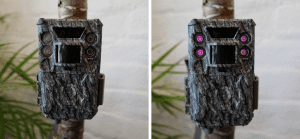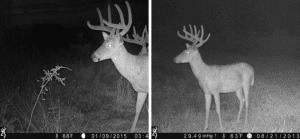No-glow & Low-glow: What’s The Difference?
You’ve probably noticed when looking for a trail camera that they will all mention their LEDs. All camera traps use infrared (IR) LEDs so when they go off, the ‘flash’ they give off is invisible to humans and wildlife.
Trail cameras will use one of two LED types; low-glow or no-glow, and it can be a little tricky to understand the differences and know which one is best for you.
Here we’ll talk you through the differences between low-glow and no-glow LEDs, the strengths and weaknesses of each and give a few recommendations on which you should go for depending on your needs.
Low-glow LEDs
These can also be called ‘Standard’, ‘Clear’, or ‘850nm’ (after the spectrum of light they use) and are the most common type of LEDs in trail cameras. Although the light they emit is invisible, when the camera trap triggers at night, you would see a faint red glow from the LEDs that would look a little like a standby light on a television. The images below are both from the same low-glow camera, showing you what the LEDs look like pre and during trigger.

The trade-off of having this slight glow however is that you get much better results. Mentioning which spectrum of light they use is important because this is what gives low-glow LEDs their advantage. The 850nm spectrum of IR light is closer to visible light – giving you a better IR flash range so you can spot wildlife easier and at bigger distances. It gives you around 30% extra IR light compared to a no-glow camera which is a pretty big gain!
It also means that low-glow trail cams typically have faster shutter speeds in photo mode so moving animals are captured with minimal blur and the definition on night videos is also much better.
What About Wildlife – Won’t They Notice That Glow?
We get asked this a lot and the short answer is generally no.
It’s a fair assumption that even professional researchers and biologists make, that going for a no-glow camera would be a no brainer so wildlife isn’t disturbed or certain more curious species aren’t attracted to the camera, but in reality it won’t make that much difference to the animals.
There is strong evidence that the majority of mammal species see low-glow and no-glow LEDs in the same way – in other words, they see a red glow regardless of the LED type used.
There’s a bit of an asterisk here for bird species as they have similar sensitivity to IR light as humans so they can see the low-glow but not the no-glow.
Effectively, if you’re using your camera solely for wildlife monitoring you may as well use a low-glow camera and get the better quality. However, if you have any security concerns or are trying to capture people, you may want to consider a no-glow LED camera. An extra bonus is that low-glow LED trail cameras are also often cheaper than the no-glow equivalent!
No-glow LEDs
Also known as ‘Covert’, ‘Black Flash’ or ‘940NM’, these do not give off the faint red glow when they trigger at night meaning they are almost completely invisible to humans.
This advantage however comes with a major setback – the loss of around 30% of the IR light that the same number of low-glow LEDs would give off. This is because it is further from the visible range of light.
To try and offset this substantial loss of IR light, no-glow LEDs are developed to try and compensate for the difference such as using more LEDs (an example of this are the Bushnell Core models), but despite this, the loss of IR light imposes a lot of limitations on a no-glow camera:

Which One is Best for You?
Like with all cameras no one size fits all and it will come down to what you’re looking to achieve with your camera.
Use low-glow if: It is solely for use in your back garden or on your own land and/or you don’t have concerns about alerting humans to the camera’s presence. You’ll get good results from the extended flash range and subsequent quality that low-glow LED cameras give.
Use no-glow if: You’re planning on using your camera in a public place (with the appropriate permissions) or are trying to get images of a particularly sensitive animal – just ensure you site the camera so the animal comes within the flash range. To help with this you can find more on placement and settings here.
Just a reminder that recent research shows that many animals can actually see the infrared spectrum of the low-glow and no-glow LEDs – so don’t be surprised if your fox has a glance at your camera even if you chose no-glow!
No-glows are also recommended for security applications unless mounting the camera quite high and above eye-level. It can however be a trade-off of wanting LEDs with a strong range or wanting to be completely covert.
The Takeaways
Helping You Choose
To help you best understand the features of each camera trap when browsing our shop, our quick-look feature icons will help.
Look out for these icons on our product pages so you can see at a glance which camera is best for you.
You can find more information about how camera traps work here.
Happy Camera Trapping!
The content of this article is copyright of NatureSpy. All rights reserved.
You may print and/or download its contents for your own personal, non-commercial use only.
Re-sale, commercial exploitation, third-party use and any redistribution or reproduction of part or all its contents in any form is prohibited without express written permission.
Nor may you transmit or store any of its contents in any other website or other form of electronic retrieval system.